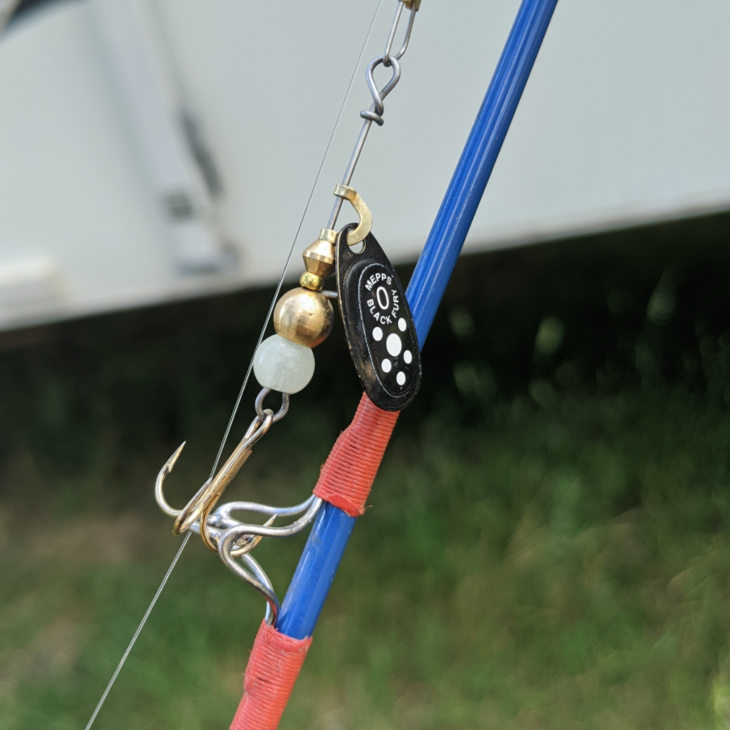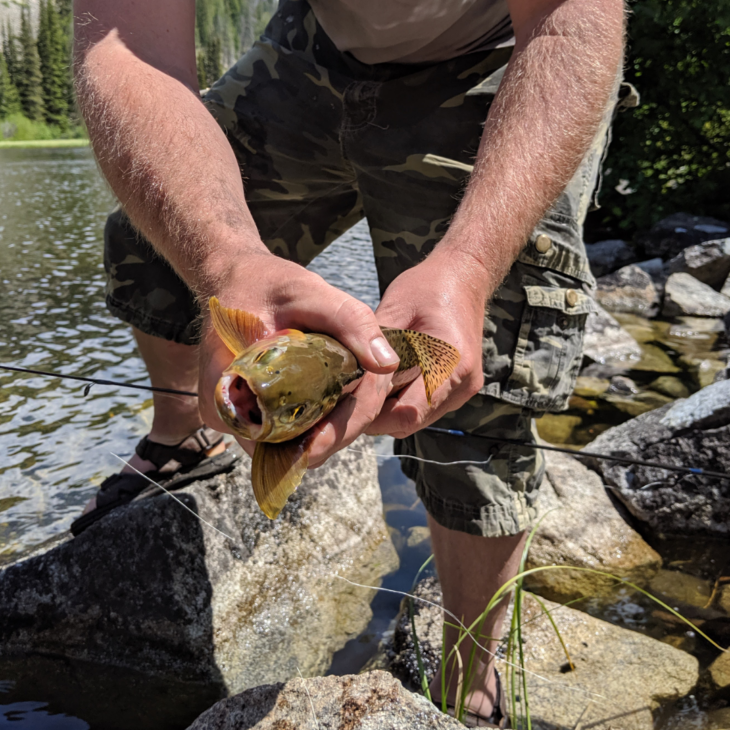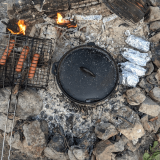Fishing is one of the best American past times. It is also a great sport and activity to learn new skills, stay active and enjoy the outdoors. I love fishing. There is nothing better than a bad day of fishing than when you are whooping and hollering because you caught a fish. I do mainly creek and lake fishing, by myself or with the kids. There is always a pole in the car or camper or backpack. We rarely keep our fish to eat unless they are injured and prefer to catch and release instead.
I did not grow up fishing, unlike most of my friends. We all grew up in Montana, but fishing wasn’t really something my dad ever took me to do. Camping was our thing, so I didn’t get introduced to fishing until I had kids. My mom tells me stories about fishing when she was a kid, but she never took us. It makes me a little sad that I wasn’t able to share those kinds of memories with my parents. That’s why I take my kids fishing as often as possible.
Being good at fishing takes time and practice and a bit of luck. I am constantly learning more and practicing more so I can get better. I know enough to be able to enjoy it, and usually catch a fish or two, and be able to teach my kids or anyone else who tags along and wants to learn to fish. My kids have been fishing since they were barely walking. There are lots of different kinds of fishing methods like cast and bait fishing, fly fishing, Tankara fishing, ice fishing, and spinner fishing. I do all of it but prefer spinner fishing.
Fishing should be fun and easy. That is why I suggest spinner fishing for beginners and kids because it is simple and not complicated. It is a great way to start learning how to fish because of the minimal equipment required and it’s perfect for fishing on the shore or bank. Fishing should be an affordable sport for all ages and shouldn’t require huge amounts of gear. I’ve put together this simple and informative guide to teach kids and beginners to fish using a spinner rod. In this post, you will learn everything you need to know on how to start fishing with a spinner.
What is Spinner Fishing?
Spin or spinner fishing uses a spinner lure instead of a fly or live bait. A spinner (also known as a spin lure, spinning lure or spinnerbait) is a lure that consists of a metal blade or tag, that essentially spins in the water when you are reeling in. The spinning of the blade attracts fish. This type of fishing is good for creeks, streams, ponds, lakes or reservoirs, and rivers. This type of fishing takes very little technique or experience, in order to catch a fish. Spin fishing can also be used to catch fish in a marine environment. Spinner fishing is good for catching a large variety of trout, salmon, crappie, and bass. Spinner fishing is also good for exercise because you are constantly in motion with little impact on your knees and back.

Basic Equipment
Spin fishing requires a rod, a spinning reel, a fishing line, a swivel, and a spinning lure. I would also recommend a small tackle box, a short length of paracord, and a multi-tool with pliers and a blade. I personally keep 2-3 lures, extra swivels, toenail clippers, and a small pocket knife in an Altoid tin wrapped with a bit of paracord, kept in my pocket. A fishing net is also nice to have, it makes the catch and release much easier and safer for the fish. QUICK TIP: FINGER NAIL CLIPPERS ARE PERFECT FOR CUTTING LINE, REMOVING A HOOK, FLATTENING BARBS ON HOOKS AND REMOVING SLIVERS.
Fishing Rod or Pole and Reel
For spin fishing, a spinning rod and reel are used. The length varies, but I usually use a 5-6 foot rod. This is a good length for both adult and kid beginners and overall a diverse size. Poles are often made out of fiberglass, graphite, and/or a carbon composite. Rods also come in aluminum and steel, but I would not recommend them. Who wants to be on the edge of a body of water with a rod like that during a lightning storm?
There is the manual and or the button spinner reel. The button reel is usually better for small children because it’s easier but the manual reel gives you bit more control with casting. Purchasing the pole and reel together is recommended because it is usually more affordable than buying them separately.
Fishing poles are durable to an extent but are known to break. I have small children and I am tough on gear, so every few years we have to buy new ones. There are poles out there that are very expensive, but usually, you can find a reel and rod combo for less than $50.00. What’s nice about spinning rods and poles is that if the reel or the rod breaks, you can just replace that piece. Most reels and rods are interchangeable. Also, the small kiddie rods are fantastic for ice fishing or if you don’t feel like carrying around a long pole. I have caught just as many fish with a little fishing pole as I have had with my adult one. We usually switch our kids from a kid-sized rod to an adult one around the age of 10. Keep in mind that most fishing poles are made for people who are right-handed. Some poles come with an interchangeable handle or my daughter who is left-handed just flips her pole over.
I did buy new poles this year and a new reel for my husband for his backpacking pole. I bought two 6 foot rods and a kiddie pole for less than $15.00 each, and a telescopic pole for backpacking for less than $40.00 at Walmart. We tried them out this last weekend and caught lots of fish. Just because a rod doesn’t cost a lot of money, doesn’t mean that it isn’t a good rod. A good time to buy fishing poles is around the holidays or the end of summer. Our family’s favorite brands are Ugly Stik, Zebco, Shakespeare and Eagle Claw.
Fishing Line, Swivel and Spinner Lure
There are different types of fishing line. The fishing line is made out of different materials and can handle different weights. I often just use what line the reel came with or I just go with the recommendation of whoever is loading the line at the sporting goods store. The best basic and go-to fishing line is a 6 lb. microfilament for beginners and is excellent for spinner fishing. QUICK TIP: YOU WILL HAVE SNAGS AND EXTRA LINE BECAUSE OF HAVING TO CUT IT. DON’T LEAVE THE LINE LAYING AROUND, PUT IT IN YOUR POCKET TO PUT IN THE TRASH LATER. BECAUSE LINE IS HARD TO SEE, IT IS A TRIPPING HAZARD.
Swivels are what attaches the lure to the line. Often, the package will include a diagram of the basic fisherman’s knot or uni knot. The swivel makes it so that the spinner moves correctly in the water, as well as making it easy to switch out lures without having to cute your line. The swivel just hooks onto the lure. In the video below, you can see how to tie this basic knot and also a demonstration on how to tie the loop knot. The basic fisherman knot is really the only one you need to start fishing.
As I said previously, a spinner lure is a hook with a metal blade attached that spins while you reel it in, attracting your fish. I love spinners because I do not like handling live bait. Also, live bait like worms or night crawlers isn’t always available. Spinners come in sizes and usually for creek or lake fishing, I like to use a 0-2 hook. Spinners come in a variety of colors and I lean more to the more natural looking ones that are brown, black yellow and white with silver or gold. Having different kinds and colors is helpful because if you are not catching anything, you can easily swap out your spinner. For example, I was using a black and yellow 2 spinner last weekend and was catching nothing. I swapped out to a black 0, and caught four fish in less than 15 minutes. My favorite spinner brands are Mepps and Panther Martin. QUICK TIP: YOU WILL LOSE HOOKS TO SNAGS, THOUGH YOU SHOULD MAKE EVERY ATTEMPT NOT TO BECAUSE HOOKS CAN BE DANGEROUS IF STEPPED ON. ALWAYS HAVE EXTRAS TO USE.
QUICK TIP: YOU CAN FILE DOWN OR PINCH THE BARBS ON YOUR HOOK IF YOU DO NOT INTEND TO KEEP YOUR FISH FOR EASIER RELEASE AND LESS HARM TO THE FISH.
How To Cast
Once you have your gear, you should practice casting in your yard. Because casting is visual, I have included these two videos. It really only requires a good flick of the wrist and remember that where your wrist follows through is where you should be aiming. When casting, be sure the area around you is clear, and there are no trees or small children in the way. Snagging yourself or someone else can really hurt and if you get your lure stuck in a tree, it can be tricky to remove it.
Before You Go Fishing
Always obtain a fishing license before you go fishing. You can even purchase one online, at local outdoor and sporting good stores and even at Walmart. Besides being the law, the fees from fishing licenses help support conservation. Keep your license on you at all times. Some states now allow a picture on your cell phone instead of a hard copy.
Always check the regulations in your area for any restrictions on fishing. Because of the time of year or types of fish, there may be limits on how many fish you can catch, where you can fish and even what kind of fish you can keep. For example, it is illegal to keep bull trout in most areas of Montana. The rule is “No black, put it back”.
Check with local fishermen, sporting good stores, and fishing stores to find out where fish are biting and where you can fish. Our local sporting goods store always has great advice. People who fish like to talk and you can learn a lot from them. Another great resource is your local forest service.
Go Fishing
Now it’s time to go fishing. Always make sure that you have water, sunscreen, and bug spray. I like to carry a small backpack with me and have a collapsible cooler nearby in case I decide to keep any of my fish. Find a clear spot on the bank that is not too high from the water. Start casting. Remove to reel in steadily and not to fast or slow. Keep the nose of your pole down and out of the water. Fish prefer calmer water and close to the bank. Be aware of debris in the creek or stream. QUICK TIP: IF YOU SNAG YOUR HOOK ON A BRANCH OR A LOG, TRY MOVING YOUR ROD BACK AND FORTH ANS THEN WHIPPING IT UP WITH A QUICK JERK. YOU MIGHT HAVE TO TRY YANKING IT FROM A DIFFERENT ANGLE. IF ALGAE GETS STUCK ON YOUR HOOK, A QUICK WHIP OF YOUR HOOK IN THE WATER SHOULD RELEASE IT.
If after you cast several times and you have not caught anything, try moving to a different spot. It’s all about having fun and the spirit of fishing, even if you do not catch anything. I just like getting out and getting the exercise. As they say, “A bad day of fishing is better than a good day at the office”.

How to Bring in Your Fish
When your line jerks, chances are you have caught a fish. Slowly reel it in but keep the tension on the line. Once you have it close to the shore, you can catch it or grab it with the net. Gently grab the fish with one hand, and grab the hook and line with your other hand. Gently remove the hook, being careful not to rip the jaw. If the fish has swallowed your hook, it’s best to keep it for eating. While unhooking the fish, try to do it as quickly as possible and keep the fish close to water. If you are having difficulties removing the hook, gently place the fish back in the water for 10-20 seconds and attempt again, so that it is not suffocating. Once the hook is removed, you can release it back into the water if it is uninjured.
If you intend to keep your fish, you can humanely kill it by stunning or spiking. For more information, check out this post from the Kayak Guru on how to humanely kill a fish for eating. If the fish is injured, do not release it. Instead, you should keep it for eating. Be responsible and don’t waste it or leave it to suffer.
How to Gut Your Fish and Keep It For Eating
You can easily clean and gut a fish in just a few minutes. Be sure to clean your fish before eating and this shouls be done immediately before you put it on ice. Fish must be kept cold in order to keep them from spoiling. The cookbook “Fish” by Jon Wipfli (check out our review here of this amazing cookbook and guide for cooking and cleaning fish) has a good cleaning guide or check out this post from Wild West Trail. Be sure to dispose of your waste properly and not throw it in the water or in the bushes.
And there you have it, the complete guide on how to fish for kids and beginners. If you need additional resources, I really the “250 Amazing Fishing Tips” book and “Fishing For Dummies”. My favorite websites are Honest Fishers and the Kayak Guru.
I hope you have learned from this post. Fishing is a wonderful way to create memories. It has so many benefits such as getting exercise, teaching patience, and teaching how to respect nature. Have you ever gone fishing? Do you have any questions that I can answer? And don’t forget, may you always have tight lines.




















Amanda
I didn’t grow up fishing and I always feel a little ignorant that I know nothing about it. This post was helpful for newbies like me! Adorable photo of the little guy with daddy learning to fish, too!
admin
Thank you!! This little guy just caught his first fish all by himself last weekend, at 4!!
Santana
I’m excited for the time when our daughter is old enough to learn how to fish. She’s only five months old now. I don’t want to wish time away. I’ll wait patiently.
Jessica
These are great tips I think we could use with our kids, thanks! I fished here and there growing up, but not enough to know all about it.